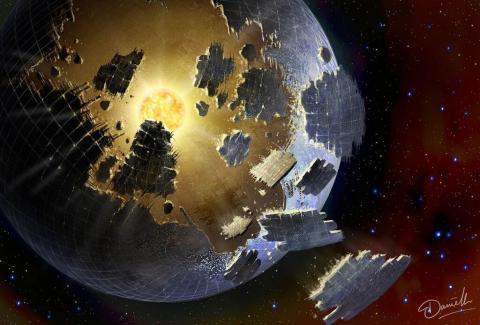Mystery dimming of 'alien megastructure' star is a load of interstellar junk
Scientists propose swarm of comets and planetoids is also causing light dips around another undiscovered star.

The unusual dimming of the 'alien megastructure' star KIC 8462852 could just be a load of interstellar junk – a swarm of comets and planetoids blocking out some of its light at irregular intervals. Scientists Valeri V. Makarov and Alexey Goldin say the smaller dips in light could be explained by another, as-of-yet undiscovered star, sitting along the same line of sight.
Bizarre dips in light coming from KIC 8462852 were noticed by astronomers using data from Nasa's Kepler spacecraft in October 2015. Researchers noticed something was blocking out light from the star intermittently – sometimes by as much as 20%. This is a huge amount of light – a Jupiter-sized planet would block around 2% of light when it passes in front of our Sun, for example.
Many theories have since been put forward as to what could be causing such large dimming, the most elaborate being that an advanced alien civilisation has built a huge structure around the star in order to harness its energy. Other suggestions include comets orbiting the star or a massive disk of dust .
Not all of the dips in light were so pronounced, however. In their latest study, which appears on the pre-print server arxiv.org, Makarov and Goldin looked at the smaller dips in light during the period the star was observed. These ranged from between 0.1% to 7% of the light being blocked out.
Their findings showed the dimming periodically came from a different source – not KIC 8462852. By plotting out the locations of the dips, they suggest there is another currently unknown star relatively close to KIC 8462852 and that some of the dips are in light are coming from this.
While KIC 8462852 is still responsible for the biggest dips, the change in position of the light means we can rule out an alien megastructure. Instead, the scientists say there could be a swarm of interstellar junk – comets and planetoids – flying around in between us and the two stars.
"We consider a large swarm of interstellar objects ranging in size from small comets to planetoids unrelated to the target star, traveling in the interstellar space, which happened to cross the line of site to the target and, perhaps, its near neighbours on the sky," they wrote.
"The irregularly spaced events are explained as randomly timed occultations from different parts of the swarm. Such free-traveling swarms can be the remnants of catastrophic disintegration of a rich exoplanetary system or a star-formation episode in a depleted molecular cloud."
© Copyright IBTimes 2025. All rights reserved.






















